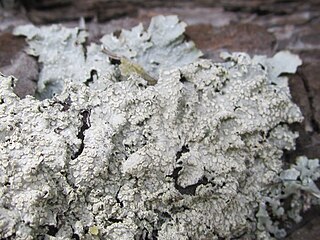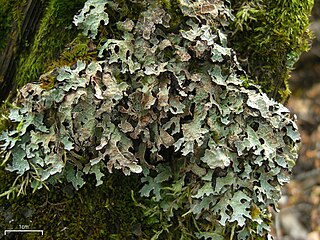
Canoparmelia is a genus of lichen-forming fungi in the family Parmeliaceae. The widespread genus contains about 35 species. Canoparmelia, a segregate of the parmelioid lichen genus Pseudoparmelia, was circumscribed by John Elix and Mason Hale in 1986.

Esslingeriana is a fungal genus in the family Parmeliaceae. The genus is monotypic, containing the single foliose lichen species Esslingeriana idahoensis, commonly known as the tinted rag lichen. It is found in northwestern North America.
Relicina colombiana is a species of saxicolous (rock-dwelling), foliose lichen in the family Parmeliaceae. Found in high-elevation páramo of the Eastern Cordillera in Colombia, it was described as new to science in 2011.

Bulbothrix cinerea is a species of lichenized fungi within the family Parmeliaceae. Among other Bulbothrix species, only B. isidiza has isidia combined with an underside that is light coloured. B. isidiza's laciniae are wider, while its thallus is pale, and contains salazinic acid. In turn, B. ventricosa is larger and a black underside and rhizinae. The African species B. decurtata is an obligately saxicolous lichen, and while similar, it has a dark underside and produces salazinic acid in its medulla. The species' name thus refers to its uncommon dark gray colouration of its thallus.
Bulbothrix meizospora is a species of foliose lichen in the family Parmeliaceae. It is found in Africa, Asia, and South America, where it grows on tree bark.
Hypogymnia congesta is a rare species of foliose lichen in the family Parmeliaceae. Found in China, it was formally described as a new species in 2003. The lichen grows on the bark and wood of conifers and bamboo. Hypogymnia congesta has a brown to brownish-grey foliose thallus measuring up to 8 cm (3.1 in) long or broad, with a cartilage-like texture. The lichen is chemically distinct, containing physodic acid and virensic acid; the latter substance is otherwise unknown from genus Hypogymnia.
Punctelia constantimontium is a species of foliose lichen in the family Parmeliaceae. Its range includes South America, Africa, and Mexico, where it grows on bark and twigs.
Punctelia colombiana is a species of corticolous (bark-dwelling) and foliose (leafy) lichen in the family Parmeliaceae. It is found in South America.
Punctelia subpraesignis is a species of foliose lichen in the family Parmeliaceae. It occurs in Mexico, South America, and East Africa, where it grows on bark and on rocks. Major characteristics of the lichen that distinguish it from other Punctelia species include the C+ and KC+ rose spot tests of the medulla, ascospores that are smaller than 20 μm, and unciform (hooklike) conidia.
Punctelia cedrosensis is a species of foliose lichen in the family Parmeliaceae. It is endemic to Mexico, where it grows on the bark of conifers.

Punctelia bolliana, the eastern speckled shield lichen, is a species of foliose lichen in the family Parmeliaceae. It is found in North America, with a distribution extending from the Canadian province of Ontario south to the central and northeastern United States and Mexico. It grows on the bark of both deciduous trees and coniferous trees. The combination of characteristics that distinguishes this species from others in genus Punctelia are the absence of the vegetative propagules isidia and soralia, a pale brown lower thallus surface, and the presence of the secondary chemical protolichesterinic acid in the medulla.

Punctelia perreticulata is a widely distributed species of foliose lichen in the family Parmeliaceae. It occurs in Mediterranean Europe and Russia, North America, South America, Australia, and New Zealand, where it grows on rocks, bark, or wood. Its main distinguishing features are its thallus surface, marked with many shallow depressions, grooves, or pits, and sorediate pseudocyphellae. The lower side of the thallus is ivory to tan towards the centre and the major secondary metabolite in the medulla is lecanoric acid. A lookalike species with which it has been historically confused is Punctelia subrudecta; this lichen can be distinguished from Punctelia perreticulata by the texture of the thallus surface, or, more reliably, by the length of its conidia.

Punctelia graminicola is a species of foliose (leafy) lichen in the family Parmeliaceae. It grows on rocks, and, less frequently, on bark in North America, South America, and East Africa. It has a blue-grey thallus measuring up to about 15 cm (6 in), covered with tiny pores called pseudocyphellae. Sometimes the lichen forms small lobes that project out from the surface. Fruiting bodies are uncommon in this species; if present, they resemble small cups with a brown internal disc measuring 3–10 mm (0.1–0.4 in) in diameter. A lookalike species, Punctelia hypoleucites, is not readily distinguishable from Punctelia graminicola by appearance or habitat alone; these species can only be reliably differentiated by examining the length of their conidia.
Parmelia ambra is a fossilised species of foliose lichen in the family Parmeliaceae. Found in Dominican amber and described as a new species in 2000, the fossil has been used in subsequent studies of lichen evolution.

Parmelia barrenoae is a species of foliose lichen in the large family Parmeliaceae. It was formally described as a new species in 2005. Before this, it was lumped together as one of several lichens in the Parmelia sulcata group—a species complex of genetically distinct lookalikes. Parmelia barrenoae is widely distributed, occurring in Europe, western North America, Africa, and Asia.

Pseudevernia consocians is a species of lichen in the family Parmeliaceae. It is found in both North America and Central America. Some characteristic features of Pseudevernia consocians are its well-developed, numerous isidia, relatively narrow lobes, and the presence of the lichen product lecanoric acid.
Parmotrema upretii is a species of saxicolous (rock-dwelling), foliose lichen in the family Parmeliaceae. Found in India, it was described as new to science in 2003 by Pradeep Divakar. The type specimen was collected near Banjar in the Kullu district of Himachal Pradesh, India at an altitude of 1,700 m (5,600 ft), where it was found growing on rock. The species epithet honours Indian lichenologist Dalip Kumar Upreti, who collected the type specimen.
Parmotrema cactacearum is a rare species of corticolous (bark-dwelling), foliose lichen in the family Parmeliaceae. Found on the Galápagos Islands, it was formally described as a new species in 2019 by lichenologists Frank Bungartz and Adriano Spielmann. The type specimen was collected from Pinta Island at an altitude of 289 m (948 ft), where it was found growing on an old cactus pad in an open woodland. It is only known from the type specimen. The species epithet refers to its substrate.
Parmotrema marcellianum is a species of saxicolous (rock-dwelling), foliose lichen in the family Parmeliaceae. Found on the Galápagos Islands, it was formally described as a new species in 2019 by lichenologists Frank Bungartz and Adriano Spielmann. The type specimen was collected from Cerro Ventanas on Floreana Island at an altitude of 424 m (1,391 ft); there, it was found overgrowing pebbles on sun-, wind-, and rain-exposed ground. The species epithet honours the authors' colleague Marcelo Pinto Marcelli, "in recognition of his work on the lichen family Parmeliaceae".
Imshaugia pyxiniformis is a rare species of corticolous (bark-dwelling), foliose lichen in the family Parmeliaceae. It is only known to occur at its type locality in the North Region of Brazil. Characteristics of the lichen include its narrow, incised lobes, lack of vegetative propagules, its pale lower cortex, and presence of the substance lichexanthone.







